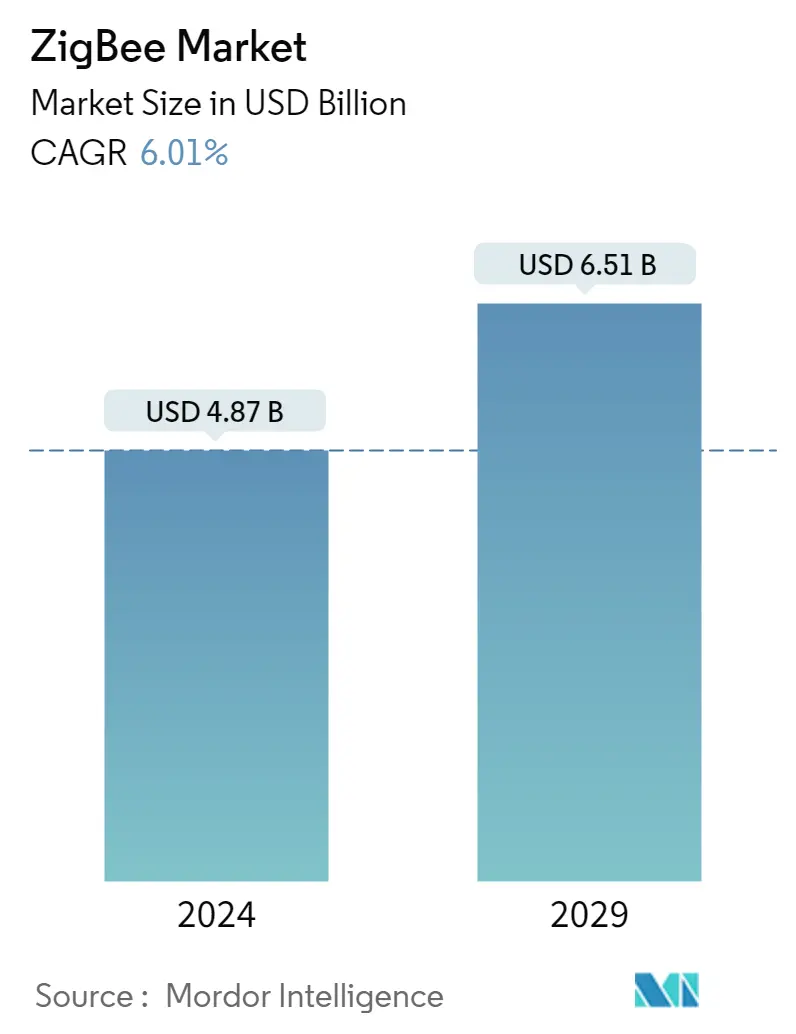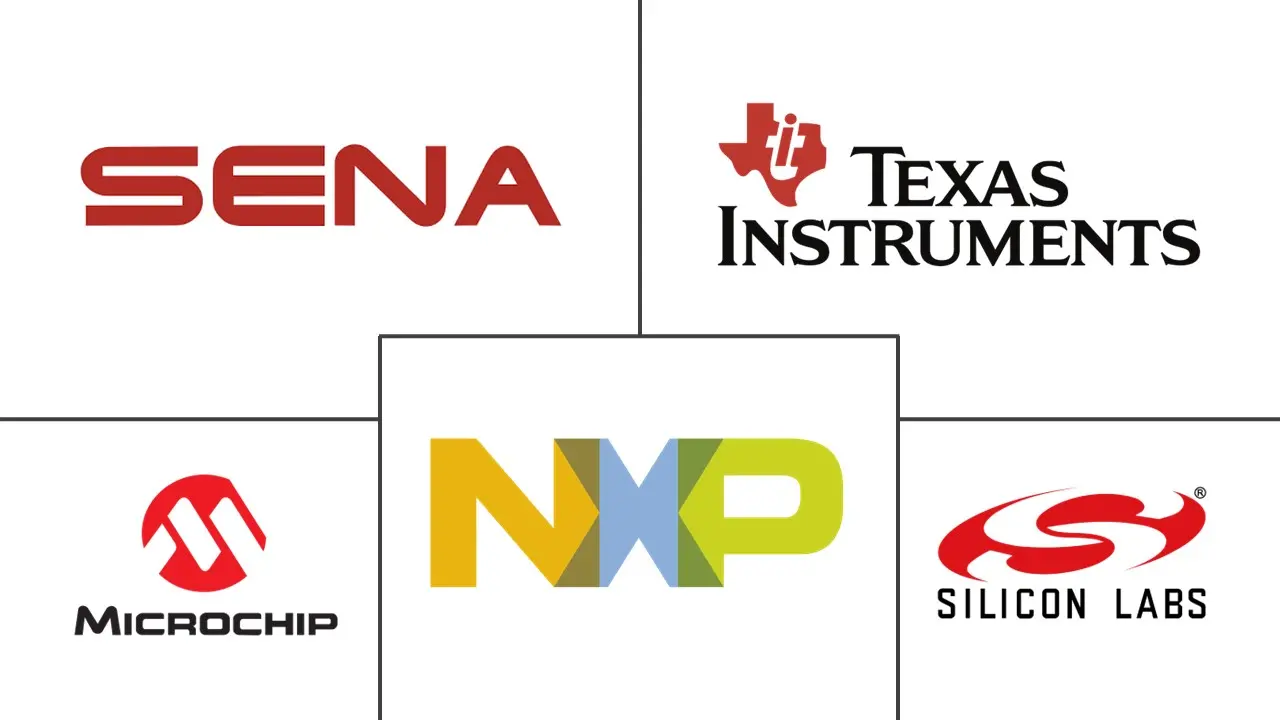Market Size of ZigBee Industry

| Study Period | 2019 - 2029 |
| Market Size (2024) | USD 4.87 Billion |
| Market Size (2029) | USD 6.51 Billion |
| CAGR (2024 - 2029) | 6.01 % |
| Fastest Growing Market | Asia Pacific |
| Largest Market | North America |
Major Players
*Disclaimer: Major Players sorted in no particular order |
Zigbee Market Analysis
The ZigBee Market size is estimated at USD 4.87 billion in 2024, and is expected to reach USD 6.51 billion by 2029, growing at a CAGR of 6.01% during the forecast period (2024-2029).
The low-cost and low-powered mesh network is widely deployed for controlling and monitoring applications, covering the range of 10-100 meters. This communication system is less expensive and more straightforward than the other proprietary short-range wireless sensor networks, such as Bluetooth and Wi-Fi connectivity.
- Due to the rising trend toward adopting smart devices, the increasing consumer electronics industry is expected to drive the application of ZigBee-based communication services used for monitoring and controlling devices based on IEEE 802.15.4 across emerging economies.
- Growing demand for the Zigbee broad-based deployment of wireless networks with low-cost, low-power solutions that can run for years on inexpensive batteries for a host of monitoring and control applications across smart energy/smart grid & building automation systems with significant advancements is expected to drive the market.
- The adoption of smart sensor technology, connectivity improvements, and advancements in cloud computing have helped drive the adoption and evolution of Industrial IoT. This trend is also expected to drive the growth of ZigBee in small industrial environments where factory devices have to communicate over a short distance.
- The Internet of Things has been growing across smart home applications. It is expected to become more customizable to give more control to users and enhance the appliance operating functions. For instance, Loup Ventures, a venture capital firm that invests in virtual reality, augmented reality, artificial intelligence, and robotics, the global smart speaker market's revenue is expected to reach USD 35.5 billion by 2025.
- ZigBee networks use a mesh topology where all devices ('nodes') can communicate with each other to form a wireless mesh network. The mesh network helps the devices share over numerous paths and regularly optimize their connections to other devices, enabling the mesh to recover from wireless interference or broken links automatically.
Zigbee Industry Segmentation
Zigbee is used in low data rate applications that require long battery life and secure networking. Zigbee communication is specially built to control the sensor networks on the IEEE 802.15.4 standard for wireless personal area networks (WPANs), which is the product of the Zigbee alliance. This communication standard defines the physical and Media Access Control (MAC) layers to handle many devices at low-data rates. These Zigbee's WPANs operate at 868 MHz, 902-928MHz, and 2.4 GHz frequencies, where the data rate of 250 kbps is considered best suited for periodic and intermediate two-way transmission of data between sensors and controllers.
| By End-user Industry | |
| IT & Telecommunication | |
| Residential Automation | |
| Industrial Automation | |
| Healthcare | |
| Retail (Digital Ecommerce) | |
| Other End-user Industries |
| By Geography | ||||||||
| ||||||||
| ||||||||
| ||||||||
| ||||||||
| Middle East and Africa |
ZigBee Market Size Summary
The ZigBee market is poised for significant growth, driven by its cost-effective and low-power mesh networking capabilities, which are ideal for controlling and monitoring applications over short distances. This communication system offers a simpler and more economical alternative to other proprietary short-range wireless sensor networks like Bluetooth and Wi-Fi. The increasing adoption of smart devices and the expanding consumer electronics industry are key factors propelling the demand for ZigBee-based communication services, particularly in emerging economies. The technology's application in smart energy, smart grid, and building automation systems is expected to further bolster market expansion. Additionally, the rise of Industrial IoT, facilitated by advancements in smart sensor technology, connectivity, and cloud computing, is anticipated to enhance ZigBee's presence in small industrial environments.
In North America, the proliferation of smart home technologies is driving the ZigBee market, with consumers increasingly viewing products like voice-activated assistants and smart security systems as standard household items. The region's robust cloud infrastructure and high density of IoT devices, coupled with advancements in artificial intelligence and machine learning, are expected to sustain market growth. The ZigBee market is moderately competitive, with major players holding significant market shares, yet new entrants are expanding their presence in emerging economies. Recent innovations, such as Silicon Labs' 3D virtual smart home platform and Microchip Technology's Smart Embedded Vision initiative, highlight the ongoing advancements in ZigBee technology and its applications across various sectors, including smart home, medical, and industrial domains.
ZigBee Market Size - Table of Contents
-
1. MARKET INSIGHTS
-
1.1 Market Overview
-
1.2 Industry Attractiveness - Porters Five Forces Analysis
-
1.2.1 Bargaining Power of Suppliers
-
1.2.2 Bargaining Power of Buyers
-
1.2.3 Threat of New Entrants
-
1.2.4 Threat of Substitutes
-
1.2.5 Intensity of Competitive Rivalry
-
-
1.3 Industry Value Chain Analysis
-
1.4 Assessment of Impact of COVID-19 on the Market
-
-
2. MARKET SEGMENTATION
-
2.1 By End-user Industry
-
2.1.1 IT & Telecommunication
-
2.1.2 Residential Automation
-
2.1.3 Industrial Automation
-
2.1.4 Healthcare
-
2.1.5 Retail (Digital Ecommerce)
-
2.1.6 Other End-user Industries
-
-
2.2 By Geography
-
2.2.1 North America
-
2.2.1.1 United States
-
2.2.1.2 Canada
-
-
2.2.2 Europe
-
2.2.2.1 United Kingdom
-
2.2.2.2 Germany
-
2.2.2.3 Italy
-
2.2.2.4 France
-
2.2.2.5 Russia
-
2.2.2.6 Rest of Europe
-
-
2.2.3 Asia Pacific
-
2.2.3.1 China
-
2.2.3.2 India
-
2.2.3.3 Japan
-
2.2.3.4 South Korea
-
2.2.3.5 Australia and New Zealand
-
2.2.3.6 Rest of Asia Pacific
-
-
2.2.4 Latin America
-
2.2.4.1 Brazil
-
2.2.4.2 Mexico
-
2.2.4.3 Rest of Latin America
-
-
2.2.5 Middle East and Africa
-
-
ZigBee Market Size FAQs
How big is the ZigBee Market?
The ZigBee Market size is expected to reach USD 4.87 billion in 2024 and grow at a CAGR of 6.01% to reach USD 6.51 billion by 2029.
What is the current ZigBee Market size?
In 2024, the ZigBee Market size is expected to reach USD 4.87 billion.

